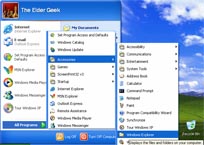The computer helper: Take charge of Windows Explorer
Washington - The Windows Explorer file manager is one of the most frequently used applications in Windows. That's no surprise, really, since files, after all, are what computers are all about. And you need a file manager to see, copy, delete, and move them. You'd think, then, that this most basic of tools could be easily customised to work the way people want. And you'd be right - up to a point. The trouble is that Windows Explorer has more than its share of quirks - even bugs. Getting around them is what this week's answers are all about.
The Windows Explorer file manager is one of the most frequently used applications in Windows. That's no surprise, really, since files, after all, are what computers are all about. And you need a file manager to see, copy, delete, and move them. You'd think, then, that this most basic of tools could be easily customised to work the way people want. And you'd be right - up to a point. The trouble is that Windows Explorer has more than its share of quirks - even bugs. Getting around them is what this week's answers are all about.
Q: Windows Explorer in XP remembers its last size and position. In Vista, this rarely seems to happen. How can I get Vista Explorer to remember its size and position?
A: Vista's Explorer is puzzling indeed in this respect. The matter is even worse with Vista's Control Panel, which rarely seems to remember its size and position settings from the last time you opened it.
But there's a trick you can use to force Vista's Explorer to remember its last size and position. To do so, simply hold down the Ctrl key and close the Explorer window. The next time you open Explorer, it should appear in the exact same size and position it had the last time you used it. The same trick is supposed to work for other windows, including Control Panel.
Q: Windows Explorer in XP seems to forget its' settings after a certain amount of time. For example, I set up Explorer to remember to list files in Details view. This works for a while. But then, for no apparent reason, it reverts back to Icons view in a week or so. What's the deal?
A: Windows XP remembers customisation for only up to 400 folders. While that may sound like a lot, it's not, once you start using Windows on a regular basis. The only fix for this is to change a setting in the Windows Registry, which most people understandably are reluctant to edit themselves.
Luckily, there's a file that's been around for some time that can fix the problem for you. It's called Bags8000. reg, and it's available for free from a site entitled Registry Edits for Windows XP
(http://www.kellys-korner-xp.com/xp_tweaks.htm). There, you'll see a large table with lots of registry tweaks. Bags8000 is the second one, available by clicking the link labeled "Increase folder view size limit to 8000."
Right-click that link, select "Save Target As" from the pop-up menu and choose a location in which to save the file on your hard drive. Once downloaded, right-click the bags8000. reg file, and select Merge from the resulting pop-up menu. If you are prompted again, allow the script to run. Afterwards, you'll see a dialog box informing you that the settings were merged into the registry. From that point forward, each Explorer window should remember its settings.
Q: How can I get rid of the Places bar in the Open and Save dialog boxes in Windows XP?
A: The Places bar is the bar along the left side of the Windows XP Open and Save Dialog boxes. It contains large buttons intended to allow you to get to commonly used places on your hard drive quickly. If you never need to get to those places - which include My Recent Documents, My Computer, My Desktop, and others - then the Places bar simply takes up space.
You can, however, get rid of the places bar or customise is so that it's more useful to you. The easiest way to do either is to download a copy of Tweak UI from Microsoft. Tweak UI is a tool that gives you the power to customise many settings in Windows XP that would otherwise require editing the system registry - a task that few want to undertake and few should.
Download Tweak UI from Microsoft's Power Toys site (http://www.microsoft.com/windowsxp/Downloads/powertoys/Xppowertoys.m spx), and install it. Once installed, you'll find Tweak UI in your Start menu under All Programs... Power Toys for Windows. Open Tweak UI, and expand the Common Dialogs entry on the left-hand side of the Tweak UI screen. Under Common Dialogs, you'll see Places Bar. Click that. Now, to the right, you'll be able to choose whether to hide the Places bar or whether to customise it so that it shows locations that are of more relevance to you. When you're finished, click Apply, and then click OK.
Q: I've managed to get Windows Explorer to remember the settings I've given it. Save and Open dialog boxes, though, never seem to remember the way I customise them. I prefer, for example, to use Details view in Open dialog boxes. But I have to set this manually each time. Is there a fix?
A: Yes. Programmer Luke Hudson has created a free utility called OpenWide (http://lingo.atspace.com/openwide.html) that does exactly what you're looking for. Download and install it, and you'll be able easily to set the size and position of Open and Save dialog boxes as well as determine which file listing type is the default. You can even choose to exclude specific programs from the settings you define.
--- Have a computer question? Send it to the Computer Helper at jayd@csi.com. (dpa)